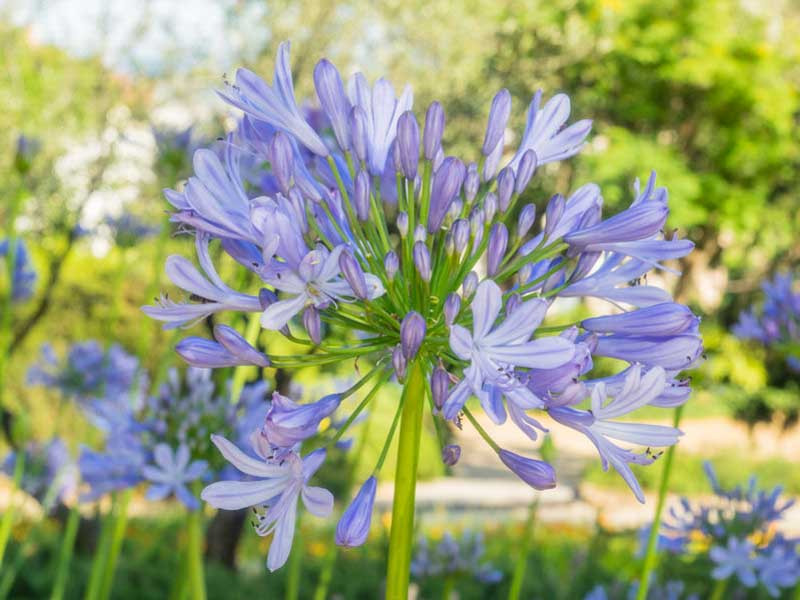Seasonal Agapanthus Care: Planning For Winter Season and Summer
Seasonal Agapanthus Care: Planning For Winter Season and Summer
Blog Article
Grasping the Art of Agapanthus Care: Important Actions for Healthy Development and Dynamic Blooms
In the world of cultivation, the farming of agapanthus stands as a rewarding endeavor for those who look for to nurture these elegant blooming plants. From choosing the right range to understanding trimming strategies, the journey in the direction of growing flourishing agapanthus plants is complex and holds the crucial to opening the full possibility of these botanical gems.

Selecting the Right Agapanthus Variety

When selecting the appropriate Agapanthus selection for your yard, consider elements such as environment suitability, bloom color, and development habit. In addition, think about the environment in your region to make certain the Agapanthus selection you select can thrive in your particular problems. Comprehending the growth behavior of different Agapanthus ranges is crucial for appropriate positioning within your garden.
Suitable Planting Problems
Considering the optimal environmental requirements is important for successful Agapanthus farming. Agapanthus thrives in well-draining soil with a somewhat acidic to neutral pH level. When growing, choose an area that obtains full sunlight to partial shade. In hotter climates, providing some mid-day shade can avoid scorching of the leaves. Agapanthus plants are delicate to chilly temperatures and need to be protected from frost during winter season.
To make sure healthy development and vivid flowers, plant Agapanthus bulbs at a depth of about 2-4 inches and area them 8-12 inches apart. Mulching around the base of the plants assists retain dampness and reduces weed development.
Watering and Feeding Tips
Preserving proper moisture levels and supplying crucial nutrients are key components in the treatment routine for Agapanthus plants. When it comes to watering Agapanthus, it is vital to strike an equilibrium. These plants favor continually moist dirt yet are susceptible to root rot if overwatered.
Fertilizing Agapanthus is crucial for advertising healthy growth and prolific blooms. Use a balanced plant food, such as a 10-10-10 formula, in the early spring as new development emerges. Repeat this application every 6-8 weeks throughout the growing season. Avoid excessive fertilization, as it can result in lush vegetation at the cost of flowers. Constantly comply with the producer's guidelines for proper dilution and application methods. By adhering to these watering and feeding tips, you can guarantee your Agapanthus plants flourish and generate vibrant, resilient blooms.
Trimming Methods for Agapanthus
Trimming Agapanthus plants at the suitable times and with appropriate strategies is crucial for maintaining their wellness and advertising ideal growth and flowering. The suitable time to trim Agapanthus is in late wintertime or early spring before new development emerges. Beginning by removing any dead or yellowing fallen go to this web-site leaves near the base of the plant. Cut them as close to the ground as possible without harming the emerging shoots.
Deadheading invested flowers can additionally reroute the plant's power into creating even more blooms rather than setting seeds. If you want to gather seeds for breeding, leave some blossoms to fully grown and dry on the plant.
Keep in mind to utilize tidy, sharp tools to make precise cuts and reduce the danger of introducing conditions. Agapanthus. Regular pruning will certainly help keep your Agapanthus looking healthy and neat while making certain an abundant display of attractive blossoms
Handling Typical Parasites and Illness
After ensuring page correct pruning methods for Agapanthus, it is crucial to resolve common insects and illness that can affect the health and vigor of these plants. One typical bug that affects Agapanthus is the Agapanthus gall midget.
One more usual concern is fungal leaf area, which provides as dark lesions on the fallen leaves. To stop fungal diseases, ensure excellent air blood circulation around the plants, prevent overhead watering, and remove any kind of infected fallen leaves without delay. Furthermore, Agapanthus plants can deal with origin rot if they are grown in poorly draining pipes soil. To stop this, plant Agapanthus in well-draining soil and stay clear of learn this here now overwatering. By being watchful and taking timely action versus conditions and pests, you can aid your Agapanthus plants grow and generate dynamic blossoms.

Final Thought
To conclude, mastering the art of agapanthus care involves choosing the right range, giving ideal planting problems, proper watering and fertilizing, proper pruning techniques, and attending to usual insects and diseases. By complying with these crucial steps, you can make sure healthy growth and lively flowers for your agapanthus plants. Remember to on a regular basis check and keep your plants to advertise their general wellness and long life.
To guarantee healthy and balanced growth and lively blossoms, plant Agapanthus bulbs at a deepness of concerning 2-4 inches and space them 8-12 inches apart. By adhering to these watering and fertilizing pointers, you can guarantee your Agapanthus plants flourish and generate vibrant, resilient blooms.
One usual parasite that influences Agapanthus is the Agapanthus gall midget. Additionally, Agapanthus plants can suffer from origin rot if they are planted in poorly draining pipes soil. By complying with these important actions, you can make sure healthy development and vivid blooms for your agapanthus plants.
Report this page